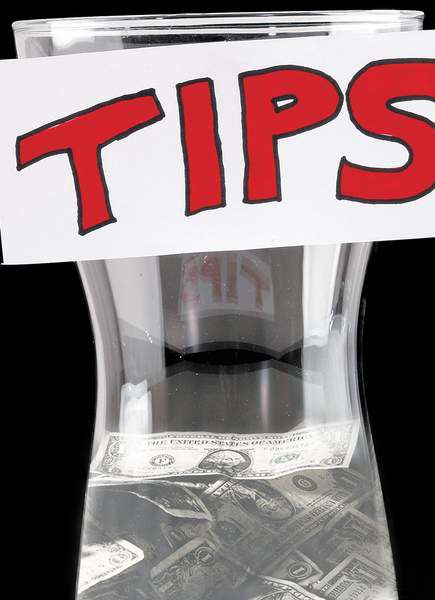Your gratuity guide
Published 4:00 am Wednesday, February 4, 2009

- Photo by Rob Kerr, illustration by Jennifer Montgomery / The Bulletin
Bend Taco del Mar owner Chris Arathoon sees a slice of human nature drop into his tip jar every day.
The canister at his Century Drive store is emblazoned with, “Official Employee 401-K Matching Contribution Plan.”
Trending
Arathoon has noticed that this west Bend store gets more tips than his Cascade Village Shopping Center store in north Bend. Customers are more likely to tip quarters than dimes, nickels or pennies. Customers who use discount coupons or reward cards tip extra. If business is slow and employees have more time to talk with the customers, the tip is higher.
“I think it’s mostly an individual thing,” Arathoon explained. “People seem to set a minimum they think they should tip.”
Arathoon’s restaurant isn’t full-service, so he says tips aren’t as high as at other restaurants in which customers know they are expected to fork it over.
Sometimes it is clear when we are supposed to tip, but other times, the rules become muddy. Do you tip the gasoline attendant who shivers in the cold while he or she is pumping your gas? Do you tip your coffee barista? What about your massage therapist? Or the person who helped get groceries to your car?
It appears that tipping has no set-in-stone rules, according to those in the retail industry. Rather, it is a personal choice on the part of the consumer.
“Tipping is a social standard,” said Matt Wallaert, an Oregon-born behavioral psychologist for the financial consulting firm JustThrive.com. “But there is some debate about why we have that social standard.”
Trending
Career retail-industry worker Daniel Butler, of the National Retail Federation, says little tipping exists in the retail world outside of restaurants. Instead, you’ll primarily see it in the service industry: hotel housekeepers, doormen and -women, taxi drivers and the like.
He echoed Arathoon’s observations on the art and etiquette of tipping.
“Tipping seems to be a very personal thing for most people,” Butler said. “Most people have definite internal guidelines they create for how and when they tip.”
Tipping is born
Historically, tipping was a method of monitoring one’s work, Wallaert says. It gave service workers an incentive to treat customers well and work for their money. You’ll still see this today, notably with employees who are paid on commission.
But there is a lot more to it.
“We know that income disparity matters,” he said. That means if you perceive the employee to be financially worse off than yourself, you will tip them a higher percentage of the ticket.
“So if you’re at a dingy little deli, you’ll tip a higher percentage than for a waiter at a fancy restaurant,” he said, “because (the fancy restaurant worker) is perceived as needing it less.”
Of course, the quality of service matters, but customers judge on a whole variety of observations, Wallaert said. For example, people tend to tip more if they perceive the employee to be working through difficulties. Additionally, customers like employees who share their accent or speech patterns or use similar body language, Wallaert said. Tips also go up when there’s good eye contact, a warm smile and a confidence that engenders trust from the customer.
“We also know that if (the server) connects on a personal level with the customer, the tip is higher,” Wallaert said. “They are being empathetic and, as a result, psychologically closer to us.”
Oregon has a relatively high minimum wage, and no “tip wage,” in which service workers earn a reduced hourly wage because their tips are expected to make up the difference. This might affect the tipping percentage here, because Oregonians perceive service workers as making more money than someone in a state with a lower minimum wage and a “tip wage.”
Hair stylists and manicurists typically are very social, which makes them more likely to earn a tip. Conversely, gas station attendants usually make minimal contact with customers.
“We don’t get out of our car and we exchange just a few words with them,” he said. “There aren’t things to feel interpersonal with a gas station attendant.”
However, if the attendant works to attract your empathy, or if you just feel sorry for him or her standing in the elements, you are more likely to tip.
“On the days when that job is perceived to be more demeaning, you’ll give more of a tip,” Wallaert said. “And that works with all sorts of domains.”
These are all subconscious judgments, Wallaert emphasizes, and vary by individual. His point is that our minds do all sorts of calculating about the person performing a service; it’s our way of determining if they have earned, or deserve, a tip.
Tipping outside the box
Some companies instruct their employees to refuse tips, saying that it is the employee’s job to give stellar service.
Both Albertsons and Safeway corporate representatives said their company does not allow or encourage tips, including at the store fuel stations or when someone helps you with your bags. Albertsons allows tips for employees at the coffee kiosks inside the stores, but Safeway does not.
At downtown Bend’s The Crepe Place, which also serves espresso, owner Jill Byers sometimes changes the sign on her tip jar to catch customers’ attention. It currently says, “Karma jar.”
“I have regulars come in who say they need good karma today,” Byers joked last week as she fried cheddar cheese for a bagel sandwich.
Like Taco del Mar, Byers’ business isn’t a full-service restaurant, so the etiquette of tipping isn’t as obvious. Additionally, she doesn’t have a “tip” line on her credit-card receipts, so those using plastic may not have the extra change or aren’t reminded to tip.
Still, Byers says customers acknowledge the shop’s work.
And she’ll continue to offer good karma for the price of a tip.







